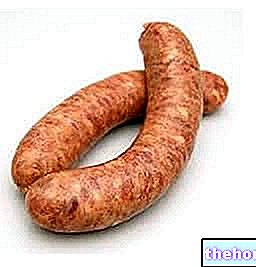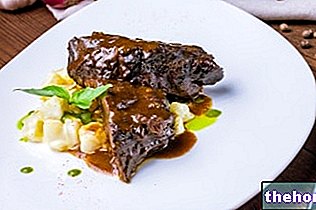Generality
The ossobuco is a cut of beef typically used in various recipes of the Lombard capital; to be precise, the ossobuco is a slice about 4cm thick obtained from the segmentation of the shank of the suckling veal.

The ossobuco is also the co-star of a unique recipe of its kind: ossobuco and risotto, also called risotto and ossobuco (this is not a play on words, in this case both foods assume the SAME IMPORTANCE). The peculiarity of this preparation is that it represents the union of two excellent recipes: ossobuco in gremolada and saffron risotto. Regarding this last spice, it is interesting to discover how, after the fall of the Roman Empire (a period in which if made an almost immoderate use of it) saffron was almost totally forgotten. Only thanks to the Milanese (therefore to the "ossobuco alla Milanese"), after many centuries its cultivation revived and also expanded outside the Navelli Plateau (in the province of "Aquila, originally the only saffron cultivation area).
Recipe of Ossobuco in Gremolada / alla Milanese
The recipe for ossobuco in gremolada (or Milanese style) is not particularly complex.
Ingredients for the ossobuco
- 1 milk veal ossobuco
- ¼ of onion
- 1 knob of butter
- 1 tablespoon of extra virgin olive oil
- ½ glass of white wine
- QB flour
- 1 glass of meat broth
- 1 clove of garlic
- QB grated lemon peel
- 1 sprig of parsley
- Salt and pepper to taste.
Procedure for the ossobuco
- Sweat the chopped onion in a pan with the butter and oil over a low heat
- flour the ossobuco (previously cut with a knife on the edges) and brown it on both sides in the pan with the onion;
- blend with white wine, let it evaporate, add salt and pepper and add the broth;
- cook over low heat with lid for about 90 "(adding broth if necessary);
- prepare the gremolada (grated lemon, garlic and parsley) and add it at the end of cooking.
Ossibuchi LIGHT Without Added Fats
Problems with playing the video? Reload the video from youtube.
- Go to the Video Page
- Go to the Video Recipes Section
- Watch the video on youtube
Nutritional Characteristics
The nutritional characteristics of ossobuco, intended as a simple piece of meat, are rather difficult to evaluate. This aspect is due to the fact that the ratio of the edible / inedible portion varies considerably based on some factors, such as the point at which it is sliced. shin and the age of the animal concerned. Furthermore, the presence or absence of bone marrow significantly affects the amount of total cholesterol in the dish.
Certainly, the most present energetic macronutrient is the protein one (with a high biological value - with a prevalence of glutamic acid, aspartic acid and lysine), followed by the lipid portion (hypothetically with a saturated or monounsaturated prevalence). As far as the saline profile is concerned, ossobuco should be rich in iron and potassium; with regard to vitamins, there are above all excellent quantities of niacin.
The average portion of ossobuco could be around 350g (including bone). Assuming a consistent dose of bone marrow and compliance with the recipe mentioned above (as regards oil and butter), the ossobuco should be consumed occasionally; moreover, given the richness of saturated fat and cholesterol, it is not the cut of meat that lends itself more to nutritional therapy against hypercholesterolemia.
We recall that ossobuco is one of those foods which, in the year 2000, suffered the commercial stop of Europe due to BSE (Bovine Spongiform Encephalopathy or "mad cow disease").
Other Foods - Amatriciana Meat Lamb - Lamb Meat Duck - Duck Meat Pork Chop Florentine Steak Boiled Broth Raw Meat Red Meat White Meat Beef Horse Meat Rabbit Meat Pork Meat Vegetable Meat Lean Meat Sheep and Goat Meat Carpaccio Ribs Cotechino Cutlet Snails or land snails Pheasant and Pheasant meat Guinea fowl - Guinea fowl meat Pork fillet Chicken Hamburger Hot Dog Kebab Patè Chicken breast Turkey breast Chicken - Chicken meat Meatballs Porchetta Quail - Quail meat Ragù Sausage Game Zampone OTHER ARTICLES MEAT Categories Food Alcoholic Meat Cereals and derivatives Sweeteners Sweets Offal Fruit Dried fruit Milk and derivatives Legumes Oils and fats Fish and fishery products Salami Spices Vegetables Health recipes Appetizers Bread, Pizza and Brioche First courses Second courses Vegetables and Salads Sweets and Desserts Ice creams and sorbets Syrups, liqueurs and grappas Preparations of Basic ---- In the Kitchen with Leftovers Carnival Recipes Christmas Recipes Diet Recipes Light Recipes Women's Day, Mom, Dad Functional Recipes International Recipes Easter Recipes Recipes for Celiacs Recipes for Diabetics Recipes for Holidays Recipes for Valentine's Day Recipes for Vegetarians Recipes Protein Regional Recipes Vegan Recipes






-nelle-carni-di-maiale.jpg)





















